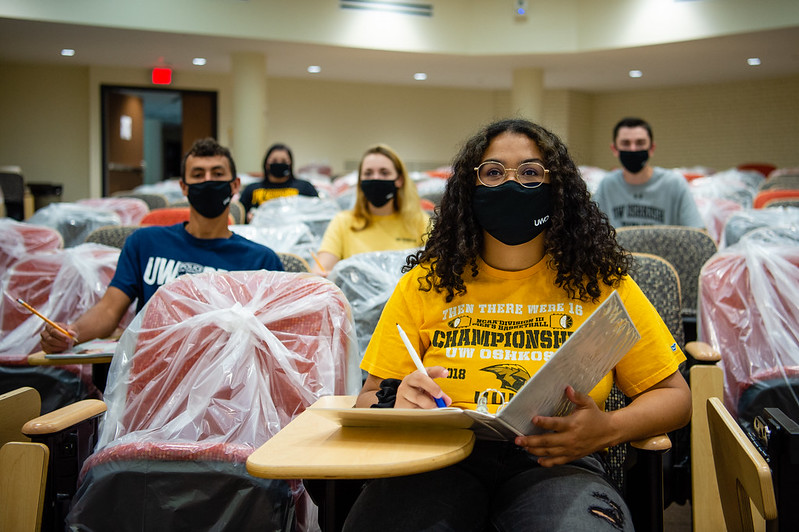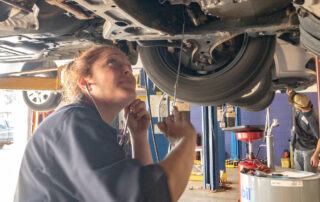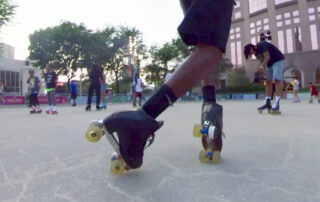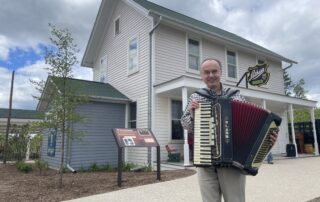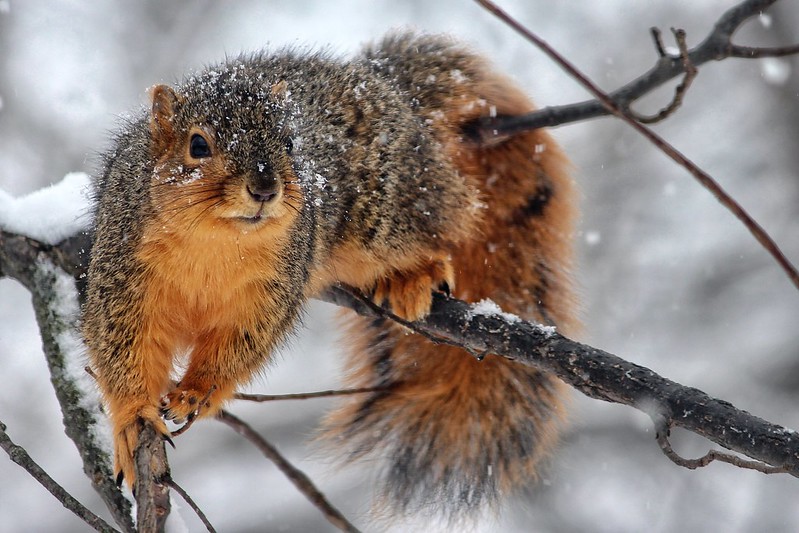People filter into an auditorium at the University of Wisconsin-Oshkosh in mid-April. They talk as audio from campus community members begins to play in the background.
Then, the auditorium goes silent as lecturer Grace Lim takes the stage. The event centered around Campus COVID Stories, a massive oral history project that documented the campus’ response to the COVID-19 pandemic, and could serve as a resource to help future historians understand the impact of coronavirus on higher education in America.
Lim opened the presentation by posing a few questions to the audience.
“Why tell the story of how students and staff at UW-Oshkosh responded to a global pandemic that has taken way too many lives? Why, after three years, would we want to revisit those really terrible, dark days?”
Her answer?
“The COVID-19 pandemic has left this mark on all of us. The lives lost, opportunities missed, plans interrupted and heroes. Yes, heroes, in all forms, stepped up. Telling the story of our collective trauma, our loss and our resilience is the goal of the Campus COVID Stories.”
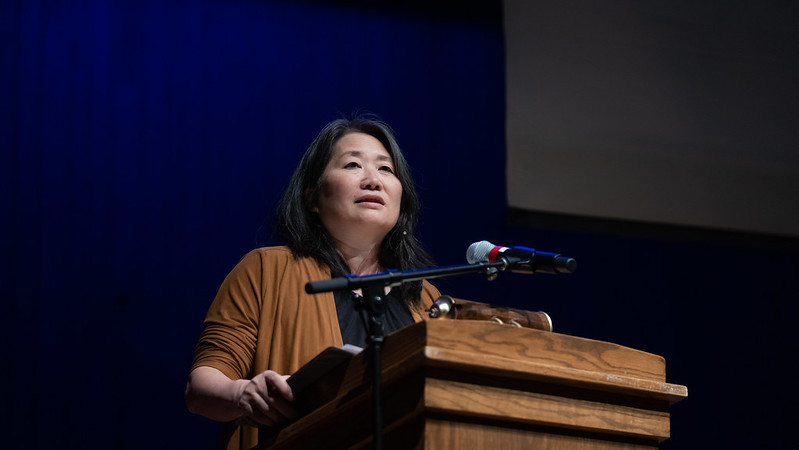
UW-Oshkosh lecturer Grace Lim gives a presentation on the Humans of Oshkosh Campus COVID Stories project. (Photo by Patrick Flood/UW-Oshkosh)
Lim has shared thousands of stories from the community for nearly a decade through the Humans of Oshkosh Facebook page and books. Almost every semester she sends students out into the city to talk to strangers about their lives.
But in the summer of 2021, Chancellor Andrew Leavitt approached her with an idea for another storytelling project. This one focused on how the campus responded to the pandemic. Leavitt shared his motivations with the audience at the event.
“When the next pandemic erupts — and it will — I want those future leaders and stewards of UWO to not only have a remembrance of COVID-19 but a humane how-to manual,” he said.
At first, Lim was hesitant. The pandemic had been really hard. At that time, she hadn’t seen her mother, who lives in Taiwan, for roughly two and a half years.
“It took me a while to understand how important this is not only for the future generations and the historians, but I think it was necessary and it is critical that we tell our stories,” she said. “We need to acknowledge that we went through a trauma.”
UW-Oshkosh’s pandemic tale mirrors many other schools in the UW System. It went virtual in spring 2020, returned to a hybrid model in the fall and gradually worked its way out of COVID precautions as vaccines and treatments became available.
But Campus COVID Stories provides — what Lim describes as — the most complete account of a campus’ response in the system.
Over the course of three semesters, Lim and her students collected over 1.5 million words from administrators, faculty, staff and students.
They highlighted the tough decisions officials had to make to reopen the campus, how the pandemic affected athletics and academics, the new challenges facing custodians, the way students felt experiencing the pandemic and the plight of UWO’s essential workers.
Archivist Josh Ranger said the campus had no such record for the 1918 Flu Pandemic.
“We do know, from the student newspapers, that school was canceled twice,” he said. “And, they came back and then shortly after, right before Christmas, they canceled classes again. But we don’t know what that meant for students’ education.”
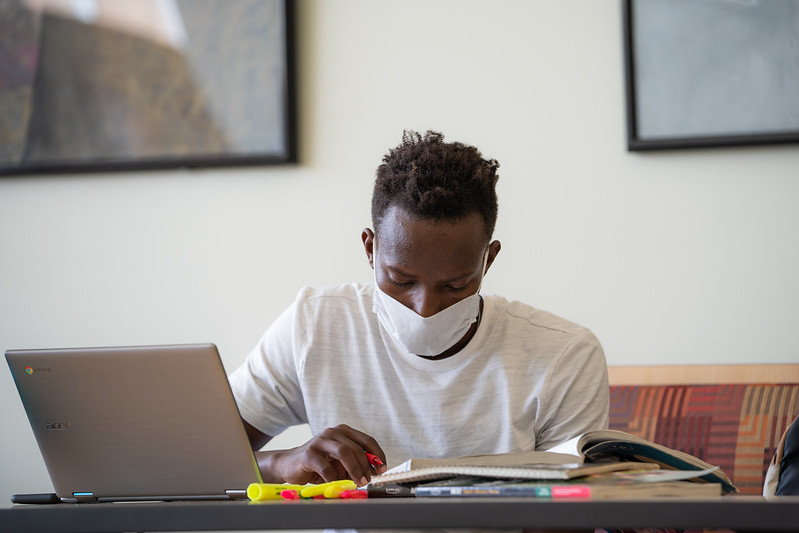
A UW-Oshkosh student wears a mask as he studies for classes. The university implemented numerous safety measures when students returned to campus in fall 2020. (Courtesy of UW-Oshkosh)
Pandemic affects college experience
The pandemic had a profound impact on the college experience of the four honors students who helped Lim bring the project across the finish line.
Cory Sparks and Tanner Sarauer were college freshmen in the spring of 2020, while Emelia Smith and MaryAnn Reindl were seniors in high school. For the Campus COVID Stories Project, they helped Lim edit transcripts, make edits to the 250-page book that was produced from the project, conducted follow-up interviews with sources and wrote articles about one person featured.
When the pandemic hit campus, Sarauer said he remembers some being excited that it gave students an extended spring break. But when UW-Oshkosh announced it would not be returning to in-person classes, that’s when the reality of the situation set in.
“Everybody kind of realized this isn’t something that’s fun for us,” Sarauer said. “That’s when the panic started happening.”
He described the move-out process as “crazy” because every dorm room was emptied in two days, the streets outside were constantly lined with vehicles picking up students and their belongings.
“Everybody was just running, trying to get out of here as fast as they could and it got hectic,” Sarauer said.
When students returned to UW-Oshkosh that fall, Sparks recalls campus feeling “apocalyptic.”
Every other chair in lecture halls were wrapped in plastic to promote social distancing, students wore masks in public spaces, large hand sanitizer bottles were everywhere and those living in residence halls had to take regular COVID-19 tests.
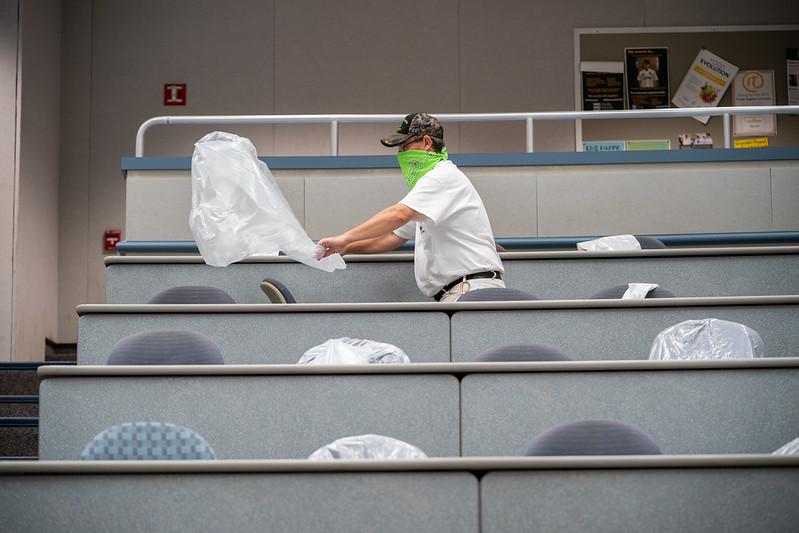
A UW-Oshkosh custodian places a plastic bag over a chair in a lecture hall on campus. To promote social distancing, every other chair in the hall was covered in plastic. (Courtesy of UW-Oshkosh)
“To go back to a campus where everything was normal a few months ago, and to see it in the state it was then was really odd,” Sparks said.
For Smith and Reindl, who were freshmen at UW-Oshkosh in fall 2020, that was their introduction to the college experience.
“In prior years leading up to college, I was really excited for the typical college experience, meeting friends and having educational opportunities,” Smith said. “But going into fall 2020, I knew that was gonna be extremely different than what I envisioned it to be.”
Both said the coronavirus safety measures became a way of life on campus, so much so that Reindl felt a little odd as they gradually began to lift.
“When things started to go away, the COVID precautions, that was weird for me,” Reindl said. “It wasn’t like coming back to normal because the COVID stuff was my normal at that point.”
She said going to class for the first time without masks felt especially strange.
“I didn’t recognize people,” she said. “Even my professors, I (mentally) filled in the bottom half of their face.”
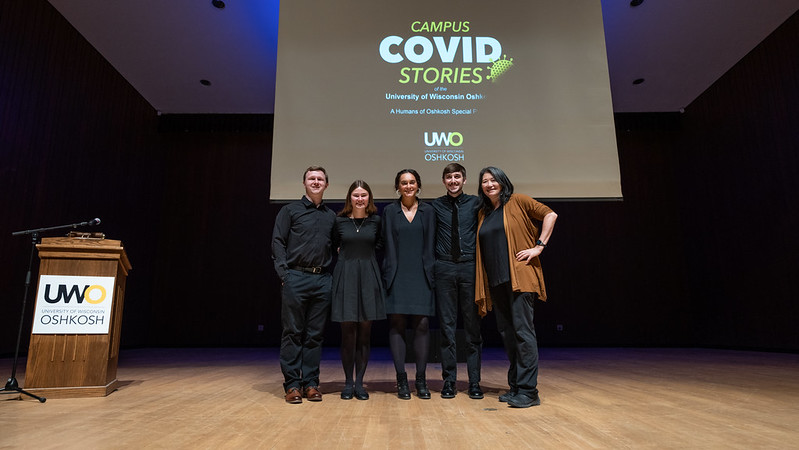
Smiling after their presentation at UW-Oshkosh are, from left, Cory Sparks, MaryAnn Reindl, Emelia Smith, Tanner Sarauer and Grace Lim. Photo by Patrick Flood/UW-Oshkosh)
Administrators make tough decisions
Many of the hard choices on campus fell squarely on the shoulders of Leavitt, and his fellow administrators.
“Everything that happens here is a part of my responsibility,” Leavitt said in his interview with the storytelling project. “Whether it’s your fault or not, it’s always going to be coming to the chancellor.”
One of those decisions was to send students home in March 2020 and pivot to online learning for the remainder of the spring semester.
That transition, for both students and instructors, was met with frustration, retiring Provost John Koker told the storytelling project.
“I think it was (a feeling of), ‘I didn’t sign up for this. This is not what I want to do. This is not what I can do.’ I think it was, again, fear of the unknown,” he said. “Where I tried to insert myself was to say, ‘This is the hand that we’re dealt and we have to do the best we can.’”
Another tough decision came when administrators decided to reopen the campus to in-person instruction in fall 2020 — before a vaccine was available.
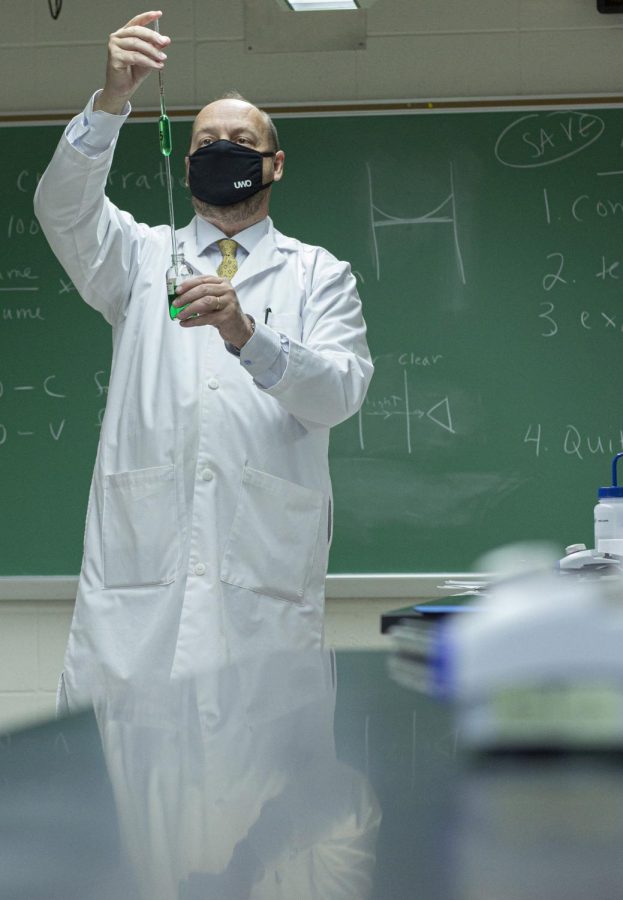
UW-Oshkosh Chancellor Andrew Leavitt teaches a chemistry lab in fall 2020. He chose to teach the lab to stand in solidarity with the university’s academic faculty. (Photo by Carter Uslabar/Advance-Titan)
To stand in solidarity with faculty, Leavitt actually taught a chemistry lab that fall.
“We had faculty who were, quite frankly, terrified about going back,” Leavitt said. “I was asking them to do something that I felt that I had to be willing to do myself.”
“I wouldn’t necessarily let the students know who I was,” he continued. “A few would instantly know who I was, and then others might go the entire semester, and not know who I am.”
One of those students was then-freshman Ellis Nabi.
“I had absolutely no idea who Chancellor Andrew Leavitt was until maybe the end (of the semester),” he told the storytelling project. “I thought, ‘Whoa, this is the Chancellor? He’s the CEO, the top dog of UW-Oshkosh. What is (doing) he teaching a lab course?’”
When positive COVID-19 cases spiked after students returned to campus, administrators discovered that some students were leaving the quarantine dorm, which wasn’t supervised at the front desk. In response, Leavitt manned the front desk of the COVID dorm over a weekend that September.
“I simply just showed up and just started doing the job and then finally others followed,” he told the storytelling project.
Titans are essential
Both the decision to vacate campus in spring 2020 and have students return that fall significantly increased the workload for UW-Oshkosh custodians.
In his interview with the storytelling project, Leavitt described them as the “unsung heroes” of the university’s pandemic response.
Custodian Vicki Stadler told the storytelling project that the pandemic created “a lot of pressure” as it constantly added daily tasks on top of getting “all the regular things done.”
“We made it safe for people to come back,” Stadler said. “Everything that was set in front of us, no matter how hard it was or how many hours it took, we accomplished that.”
Another group of essential workers who saw first-hand the worst the pandemic had to offer were UWO’s nursing students, many of whom worked as CNAs at nursing homes and hospitals in the midst of a global pandemic.
In reviewing stories from the Campus COVID Stories project, Ranger said theirs stuck out because of “just how much more responsibility those young individuals had compared to some of their peers.”
“Suddenly, they’re on the front lines,” Ranger said. “They’re working at 19 years old, seeing people die, helping people die, dealing with family members (and) worrying about themselves on top of it all.”
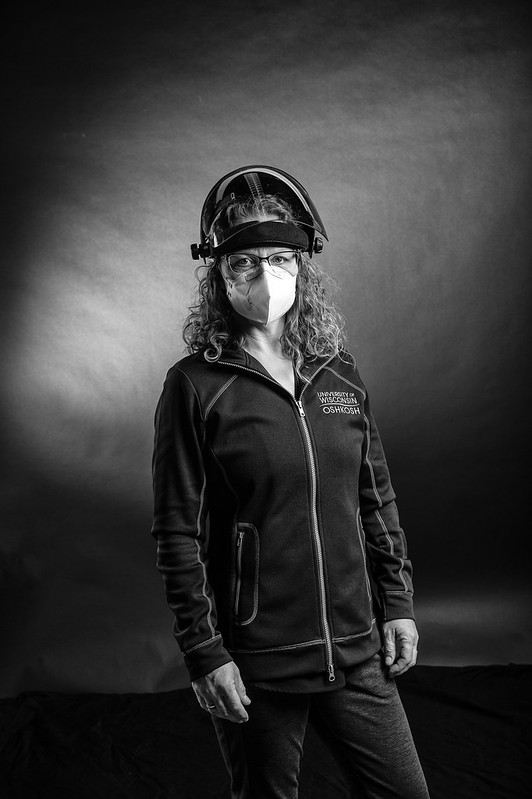
Many of lecturer Heidi Hansen’s students in the College of Nursing served as essential workers during the pandemic. (Courtesy of UW-Oshkosh)
College of Nursing Lecturer Heidi Hansen shared stories of her students with the storytelling project. She said the pandemic pushed many long-time health care professionals to the brink, as CNAs were getting their first real-life experience in the industry.
“These are kids,” Hansen said. “These are 19-20 year old kids who are alone in a long term care facility with multiple COVID patients and people dying more rapidly than they’ve ever experienced or may ever experience in their life.”
That’s why she gave this wisdom to her students: “Your grandkids are going to ask you what you did during the pandemic, and you will be able to share with them that you helped prevent disease transmission and you saved lives.”
Titans are resilient
The project also preserved Jada Berg’s experience, which helps illustrate the campus’ resilience in the face of adversity.
When she was a UW-Oshkosh nursing student, the tragedy of the pandemic hit especially close to home. She, too, was an essential worker during the pandemic as a CNA for a community-based residence facility. She took care of adults with Alzheimer’s, dementia, depression and anxiety.
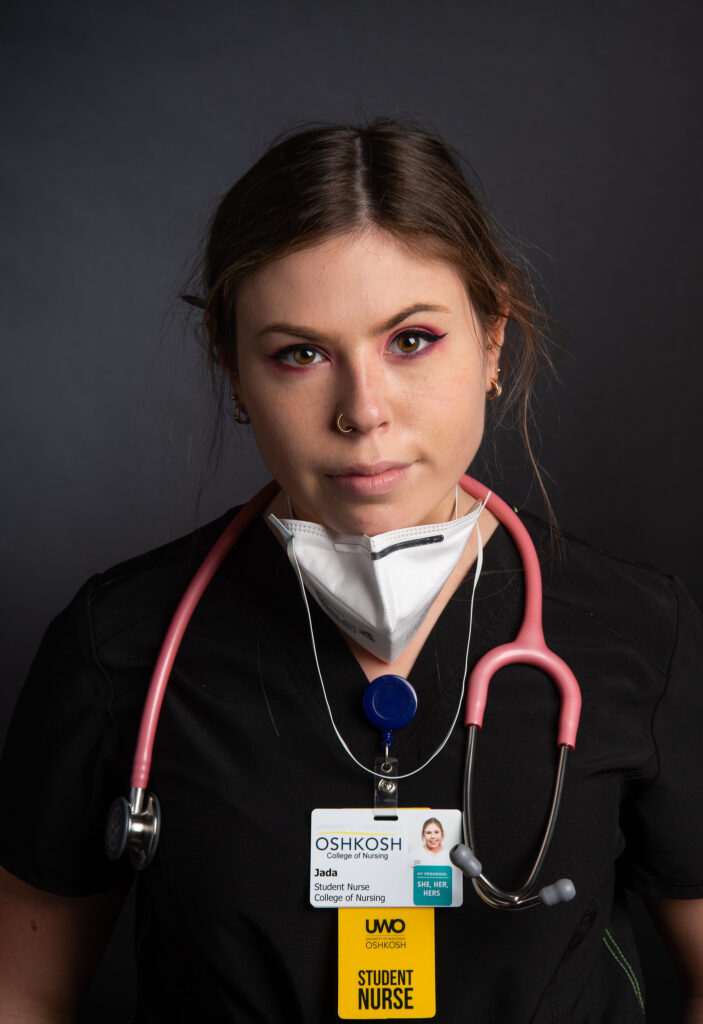
As a nursing student at UW-Oshkosh, Jada Berg was an essential worker. She also experienced a tremendous tragedy as a result of the COVID, but didn’t let that stop her from achieving her goals. (Courtesy of UW-Oshkosh)
Throughout the pandemic, Berg was extremely careful to not bring the virus home because her mother, Sue Ann Long Schneider, was immunocompromised. She was vaccinated in January 2021 because she was a health care worker, but her mother wasn’t as lucky.
Because of health issues, her mother’s vaccination was delayed but she finally got approved for the vaccine around Thanksgiving that year.
But one week before she was scheduled to get vaccinated, Berg’s mother was hospitalized with COVID-19 in early December while Berg was back at school.
Shortly after that Christmas, Berg was visiting her mother in the hospital when an alarm sounded.
“I can read EKGs because of my nursing school, and she was in ST elevation, so she was having a cardiac crisis,” Berg said. “They do the code, the doctor comes up to me, and she gives me this look that I’ve seen from a ton of doctors and a ton of nurses. It’s the (look that says), ‘We can’t do anything else, like, this is it.’”
Berg’s mother, Sue, died from COVID-19 complications.
“It’s really hard watching people still deny COVID,” Berg said. “I watched my mom honestly die a pretty bad death because of this. She was 45 years old. I lost my best friend, the absolute rock of my life.”
But Berg didn’t let that tragedy stop her from achieving her goals. She graduated in May 2022 and now is a registered nurse at UW-Health in Madison.
In many ways, her story showcases the resiliency of the UW-Oshkosh community, highlighted by the pandemic.
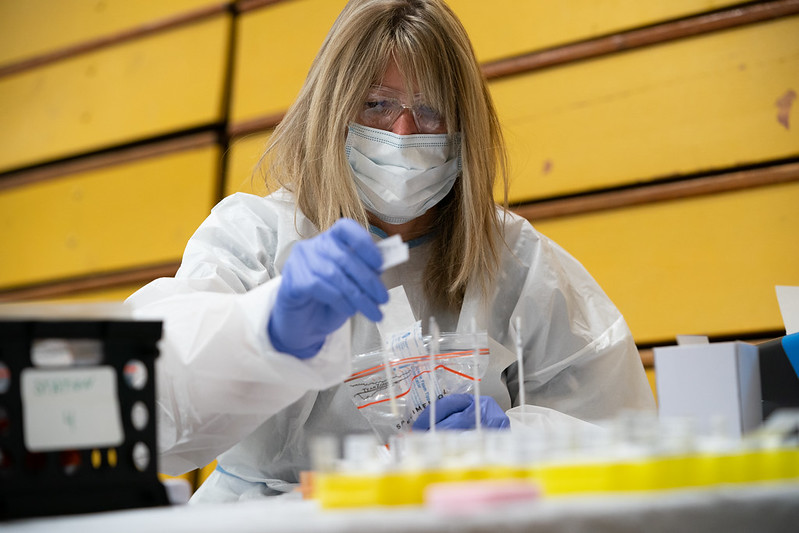
A worker helps run the COVID-19 testing center at UW-Oshkosh in fall 2020. The university implemented rigorous testing to help limit the spread of coronavirus when it returned to in-person learning in the fall of 2020. (Courtesy of UW-Oshkosh)
Another Campus COVID Story also showcases that ability to bounce back in the face of adversity is that of the UW-Oshkosh Gymnastics Team.
The team was slated to go to Nationals in 2020, before the pandemic dashed those dreams. Head coach Lauren Karnitz described her reaction to Athletic Director Darryl Sims telling her the team’s trip would be canceled.
“I remember getting into a fight, like yelling, with an assistant football coach because I was crying after Darryl had said, ‘Well Oshkosh is staying home.’ I said, ‘You can’t keep us home. We’re the best team in Division III,’” Karnitz told the storytelling project. “I remember our assistant football coach turning to me and being like, ‘Listen, there is a global pandemic happening. This is much bigger than you.’”
In 2022, the UW-Oshkosh gymnastics team had its shot at redemption. The Titans were crowned national champions that year, roughly two years after their dreams had been dashed by the pandemic.
Karnitz credited the team’s 2022 title to all of the obstacles it had to overcome during the pandemic. From having no social lives outside the gym when athletics returned to dealing with its head coach being quarantined on senior night.
“I’ve had to be more flexible, and in return, my athletes have become more flexible and I think that is what contributed to them winning,” she told the storytelling project. “No matter what happened, it didn’t matter. They were ready for it.”
That energy propelled the team to its second-straight national title this year in Winona, Minnesota.
Through the project, Grace Lim said she learned that the humans of UW-Oshkosh are extremely resilient when faced with overwhelming challenges.
“We were hit with something so big and so truly awful, and we did not buckle under the pressure, under the fear,” she said. “We managed to get through it, and we did it together.”
To listen to more Campus COVID Stories, visit https://archives.uwosh.edu/covidstories.
